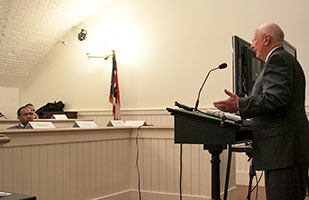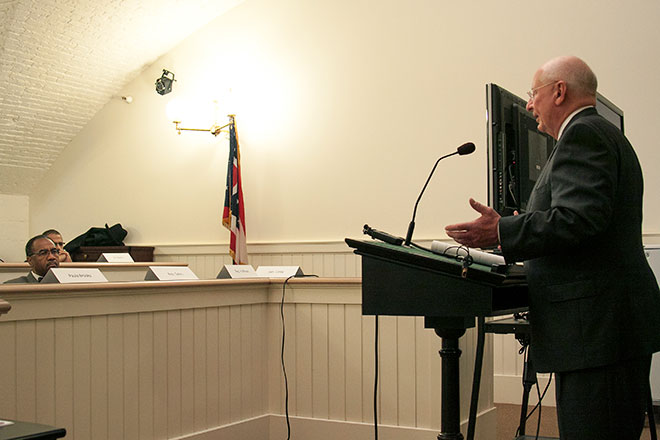Justice Pfeifer Tells Study Committee That School Funding Standards Should Remain in Constitution

State Rep Vernon Sykes, a member of the Ohio Constitutional Modernization Commission listens as Justice Paul E. Pfeifer addresses the group.

State Rep Vernon Sykes, a member of the Ohio Constitutional Modernization Commission listens as Justice Paul E. Pfeifer addresses the group.
The Only Ohio Supreme Court justice to have ruled on all four iterations of the landmark public school funding case said any proposal to remove judicial oversight of the state’s school funding methods would be a mistake and he would vocally oppose it.
Justice Paul E. Pfeifer appeared before the Ohio Constitutional Modernization Committee Thursday to address issues under debate by the body developing recommendations on modifying the state’s constitution.
Justice Pfeifer spoke to the Education, Public Institutions and Local Government Committee of the Commission, which has been receiving proposals to change Section 2, Article IV of the State Constitution. The section contains the requirement that the General Assembly provides sufficient funds to “secure a thorough and efficient system of common schools throughout the state.”
The definition of what is thorough and efficient and which branch of government decides if it is met was the cornerstone of the DeRolph school funding cases that were first decided in 1997. Justice Pfeifer was in the 4-3 majority that ruled the General Assembly had failed to provide proper funding for the schools. The court issued three additional decisions on DeRolph through 2002, but gave up any judicial oversight of the General Assembly in complying with the rulings.
Some proposals to the Commission include removing the thorough and efficient clause from the constitution or making it clear the General Assembly determines what is thorough and efficient.
Justice Pfeifer said that would be a mistake. He told the panel there certainly could be language added to make it clearer what is required to properly fund schools, but he did not have any proposed language in mind. He said it is important that no government body, local or statewide, should be “beyond reach” by its citizens in such a vital area as education.
“Ultimately the bar should be in the constitution. It serves a worthy purpose and I would caution against removing it,” he said.
Justice Pfeifer, who has two years left on his current term and is ineligible by age limits to seek another term on the bench, said he predicts it would be very unlikely that another significant school funding case would come before the court while he was still in office. He said once he leaves, he would be free to make his opinions known that he opposes removing the requirements of the state to fund a quality education for all children.
Addressing former Ohio Gov. Bob Taft, a member of the commission, Justice Pfeifer noted that while the DeRolph decision did not bring the sweeping reform he envisioned, several major changes did happen including the multi-billion dollar school construction program launched under Taft in response the court case.
“Prior to that, the state didn’t spend a nickel on public school buildings,” he said.
In addition to speaking about school funding, Justice Pfeifer appeared before the Commission’s Judicial Branch/Administration of Justice Committee to discuss the high court’s original jurisdiction provisions.


